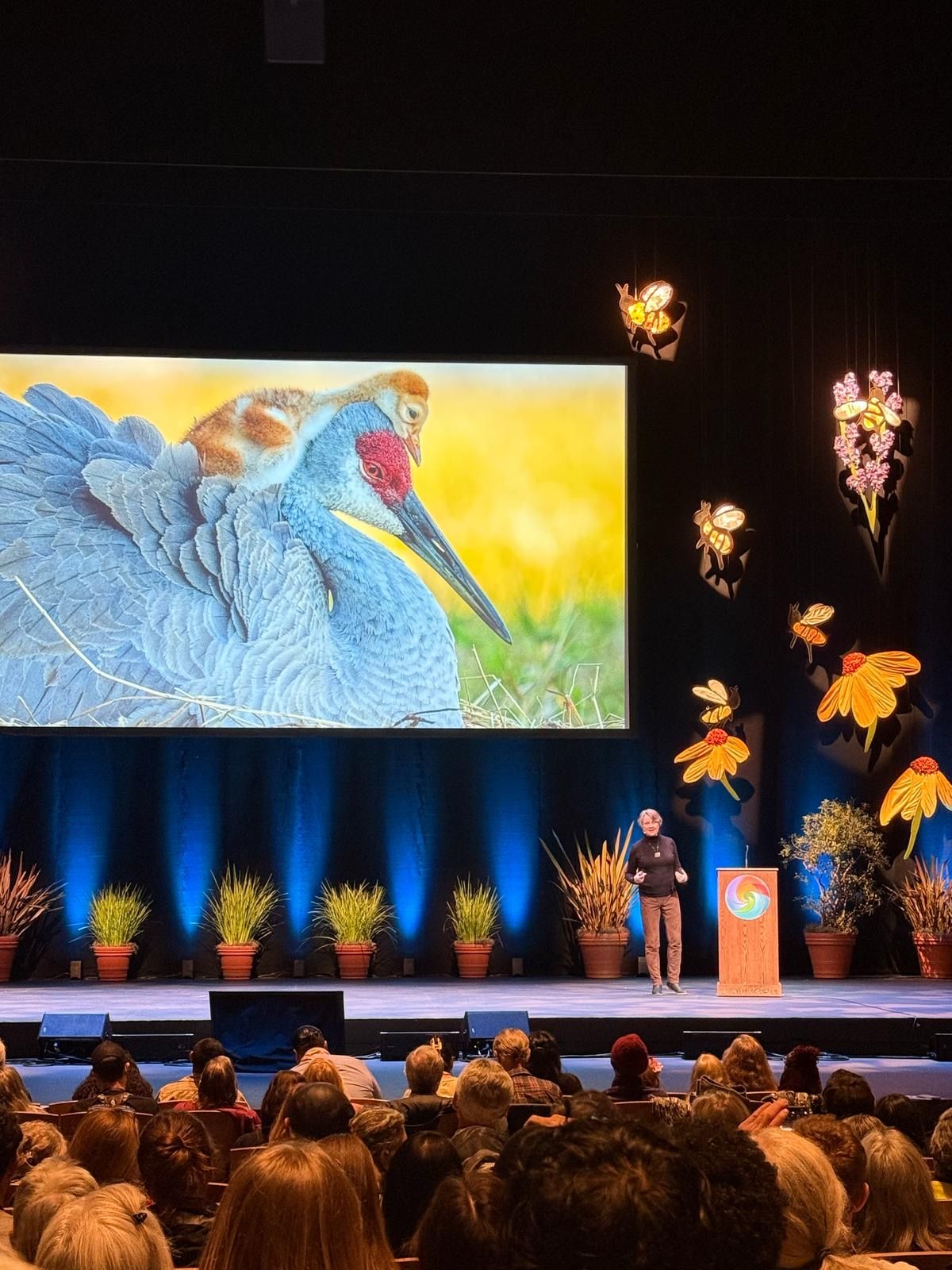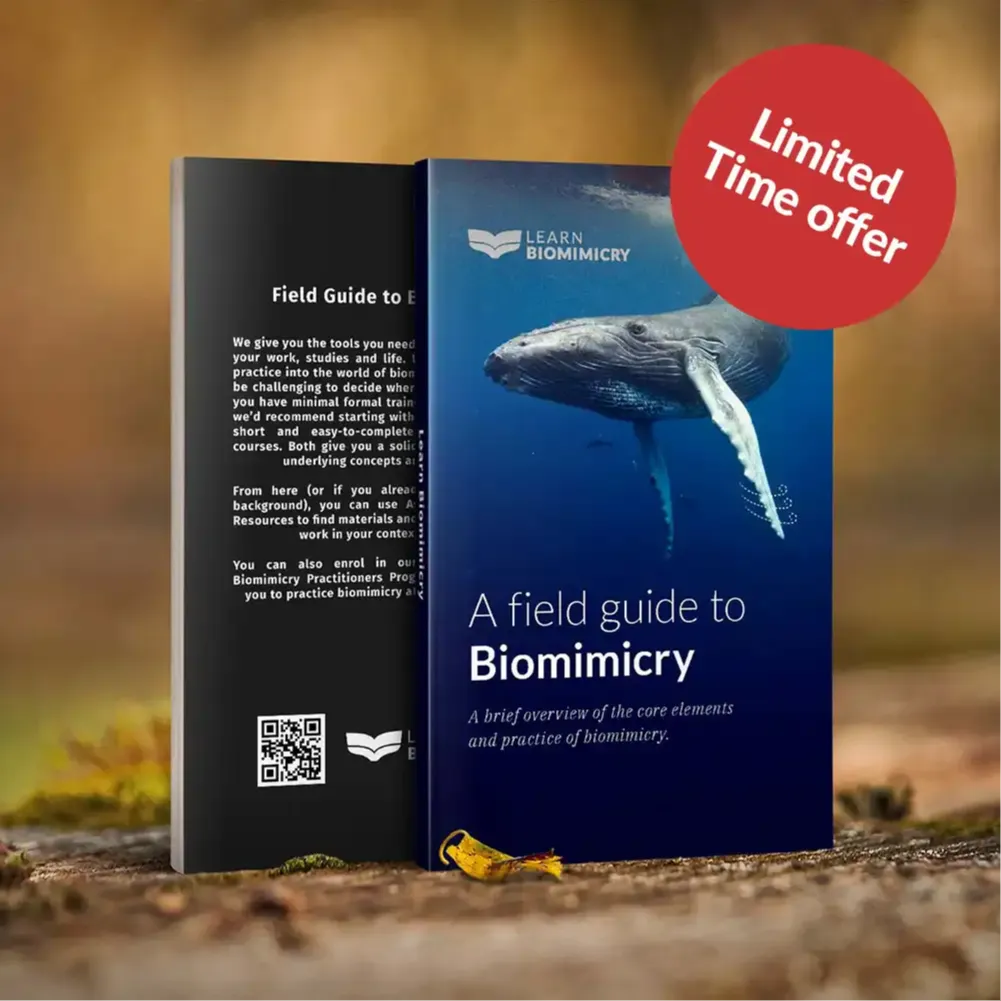10 Inspiring Bioneers and What They Taught Me

What might surprise you about the annual Bioneers Conference ... is that it’s not a conference at all. It's more akin to a ceremony, with dancing, community building, spirituality and learning. Attending Bioneers is like drinking from a fire hose of nature’s wisdom and collective knowledge. Bioneers is a coral reef of biomimics, indigenous leaders, restoration practitioners, and so much more... a diverse and flourishing ecosystem.
The speakers include some of the most brilliant thought leaders on various subjects and one can't help but walk away in awe, and feeling a renewed sense of hope.
Learn Biomimicry's Director and Biomimicry Practitioner, Alistair Daynes shares his experience of the event that took place in Berkeley, California in March 2025.
Here are 10 Bioneers from this year's conference, and key lessons that they taught us all.
1. Janine Benyus, The Godmother of Biomimicry

Okay, yes. Janine… it’s impossible not to be in awe of her. Janine was the keynote speaker at Bioneers this year… and she did not disappoint. Taking the main stage on day one, Janine left the stage to a standing ovation from a completely inspired audience.

Janine's talk was titled: "Becoming a Welcome Species: Biomimicry and the Art of Generous Design". This was not her first time taking centerstage at Bioneers. From talking to Biomimicry as a Cooperative Inquiry, The Biomimicry Network Effect, and so much more.
Janine brought a bit of humor too, reframing the "struggle for existence" to the "snuggle for existence".
My only regret of the whole Bioneers conference was not getting to meet up with Janine personally. Alas, perhaps it was not meant to be this time… but a good reason to return.
She led with the reminder that cities should function like forests — storing water, cooling the air, sequestering carbon, cycling nutrients, and promoting biodiversity.
Read more about some of Janine's work in designing the city of Lavasa, India, to mimic the local forest around it in this article: The Best Biomimicry Examples for Urban Design
My favourite quote from Janine's session: “We are young, but this is our true home. We belong here. I think our true nature is generous, because we are a biological being. We can do what life does — I know that we can. Whatever part of the earth you touch, you can help heal. Let’s find our true, generous natures.”
Thank you, Janine, for teaching us that our true nature is generous, and what unites us all is our reverence for the natural world.
2. Andy Lipkis and Designing Living Infrastructure

Andy was the keystone presenter at the "Living Infrastructure: Co-Designing Thriving Communities in Los Angeles" discussion. During this session, Andy shared their latest project - the Living Infrastructure Field Kit.
The Living Infrastructure Field Kit was built to help Los Angeles residents adapt to climate extremes while honoring place, growing participation, and regenerating life. In Los Angeles, communities are transforming neighborhoods and schools into climate-resilient hubs that capture precious water, reduce deadly heat, and provide vital gathering spaces. These projects demonstrate how infrastructure can simultaneously address technical challenges while strengthening community bonds and ecological health.
Andy Lipkis, the founder of TreePeople, a renowned, groundbreaking figure in Urban and Community Forestry and Urban Watershed Management, has demonstrated how individuals, communities, and governments can collaboratively reshape urban forests, soil, and water infrastructure to create a more liveable future. After retiring from TreePeople in 2019, Andy launched Accelerate Resilience L.A. to advance living infrastructure principles and climate resilience in Los Angeles.

Andy has grown TreePeople into an exceptionally impactful movement from 1973 to today.
Image Credit: TreePeople
Thank you Andy for sharing how we might create living infrastructure.
Interested in the built environment? Read: 10 Biomimicry Examples in Architecture
3. Toby Herzlich, Bringing Biomimicry to Social Innovation

Toby facilitated two events at Bioneers this year - Biomimicry and Justice, as well as an interactive session around Biomimicry for Social Innovation.
Biomimicry for Social Innovation is a global network of innovators and leaders who live and operate through learning from the natural world to create conditions conducive to life, and helping others to do the same. They offer exceptional resources and courses, consulting services and training retreats.
Thank you Toby for teaching us that relationship come before task.
4. & 5. Bioneer Co-founders Kenny Ausubel and Nina Simons


Kenny Ausubel Nina Simons
Kenny and Nina are two change-makers and founders of the Bioneers movement - sparking many to turn knowledge into action. What struck me the most about Kenny and Nina is how involved they still are, even 36 years on.
Bioneers is dedicated to showcasing groundbreaking solutions for healing both people and the planet. Established in 1990 in Santa Fe, New Mexico, Bioneers serves as a dynamic hub for social and scientific pioneers who develop innovative, practical strategies to address critical environmental and social issues.
The organization is rooted in a deep appreciation for nature’s brilliance and human creativity, and fosters connections between individuals and transformative solutions. Although many successful local Bioneers Network events are hosted throughout the year, the annual conference really is their flagship event that draws thousands of brilliant thought leaders from around the world.
Bioneers Learning, their educational platform, offers courses in various fields from regenerative agriculture to responsive leadership to herbalism.
Thank you Kenny and Nina for teaching us the power of learning in community.
6. Haley Mellin, Turning Art into Acres

Haley is an artist and land conservationist - two things that I too hold a deep passion for. Haley founded Art Into Acres in 2017. Art Into Acres is an artist-run, non-profit organized to support permanent large-scale land conservation on behalf of the arts community. The initiative has supported a range of new permanent protected areas including new Indigenous protected areas, community-conserved areas, municipal parks, regional parks, and national parks.
So what impact can an artist make? Here’s just a snapshot of their completed projects
- Bajo Paraguá Municipal Protected Area, Bolivia: 983,006 hectares, 2,429,061 acres
- Esmeraldas Provincial Conservation and Sustainable Use Area, Ecuador: 213,758 hectares, 528,207 acres
- Pueblos Mountains and Trout Creek Wilderness, Oregon, United States: 124,238 hectares, 307,000 acres
- and 20+ more projects which you can read on Art into Acres website here
“Great land conservation always begins at home. It begins with the people who know the landscape. It begins with the people who know how it smells, who have lived there for centuries.”
Thank you, Haley, for showing us how great art can positively create great conservation.
7. & 8. Andrew Howley and Richard Hasegawa, Asking Nature in Berkeley

 Andrew Howley Richard Hasegawa (Source: LinkedIn)
Andrew Howley Richard Hasegawa (Source: LinkedIn)
Andrew (Chief Editor at Ask Nature) and Richard (Naturalist and Ecological Field Technician) facilitated a morning walk among the eucalyptus and redwood trees on the University of California (UC) campus.
What struck me initially was Richard's deep knowledge of ecology. As a naturalist, I assumed he’d know a whole lot… but the depth of his study blew my mind!
It’s incredibly inspiring being surrounded by such passionate naturalists, biomimics and those on a mission to create life-friendly designs.
Thank you Andrew and Richard for teaching us to ask nature.

Alistair and Andrew at the Bioneers conference. Andrew often collaborates with Learn Biomimicry,
such as being a keystone speaker at the Biomimicry Confluence in October 2024.
Today, Andrew is the Chief Editor at The Biomimicry Institute and AskNature.org
9. Amy Bowers Cordalis and Returning Rivers (and Exploding Dams)

Amy’s presentation walked through the historic Klamath Dam Removal project, removing four dams. The removal of the dams, which had blocked the river’s natural flow for over a century, restores nearly 400 miles of vital habitat for salmon and other species that are essential to the river’s ecosystem and the communities that depend on them.
By taking down these outdated dams, ecosystems and species (such as salmon) have a chance to thrive once again, while also restoring an essential lifeline for tribal communities who have long depended on the health of the river.
One of my favourite lines of the entire Bioneers was when Amy paused to show a video… she looked out to the crowd and announced: "Good news - this video has explosions!"
Amy is a devoted advocate for Indigenous rights and environmental restoration as well as a fishing enthusiast, attorney, and mother; deeply rooted in the traditions of her people. She is the co-founder and Executive Director of the Ridges to Riffles Indigenous Conservation Group and leads efforts to support tribes in protecting their sovereignty, lands, and waters, including the historic Klamath Dam Removal project.

The Klamath Dam Removal Project is the biggest dam removal and river restoration effort in history!
Credit: Josh Miller
As a former general counsel for the Yurok Tribe and an attorney at the Native American Rights Fund, Amy has won many awards and honors, including being named a UN Champion of the Earth and Time 100 Climate Leader.
Thank you Amy for showing us what’s possible when we come together to prioritize our environment, our people, and future generations.
10. Lily Urmann and Learning from Nature Podcast

Lily is a biomimic, educator, and nature nerd... and one of the newest team members to join the Biomimicry Institute. She has been a leading Biomimicry Educator for a number of years, through her work as a Visiting Instructor at Pratt Institute where she teaches a course I created, titled "Biology for Biomimicry'.
Lily and I met up throughout Bioneers and afterwards too, where we recorded a podcast amongst the redwoods in Tilden Park. One of our focuses of this interview was discussing the six things that biomimicry is calling for… and asking the question - how do we further scale biomimicry? More to come in this regard.
Learn Biomimicry sponsored the third season of the Learning From Nature Podcast, as we deeply believe in making biomimicry more accessible… and what better way to bring it to others than with a podcast.
Thank you Lily for bringing biomimicry to many ears and hearts around the world.
In Closing
The Bioneers Conference should definitely be marked in every biomimic, nature enthusiast, future-oriented thinker and change maker's calendar. Learning from others, learning from nature, and mining the insights of those more experienced or knowledgeable than us is a great privilege and an exceptional experience.
Lastly, Thank you Bioneers for creates the space for biomimics to flourish!
Wild regards
Alistair Daynes, Biomimicry Practitioner
Speaker images sourced from Bioneers

Are you starting out on your biomimicry journey?
Download this free eBook: A Field Guide to Biomimicry here
and gain a solid understanding of what biomimicry is,
see examples and how to apply it in your own life.
Stay connected!
Join our Living Loop newsletter to receive the latest biomimicry updates and valuable resources. Your information will not be shared.
